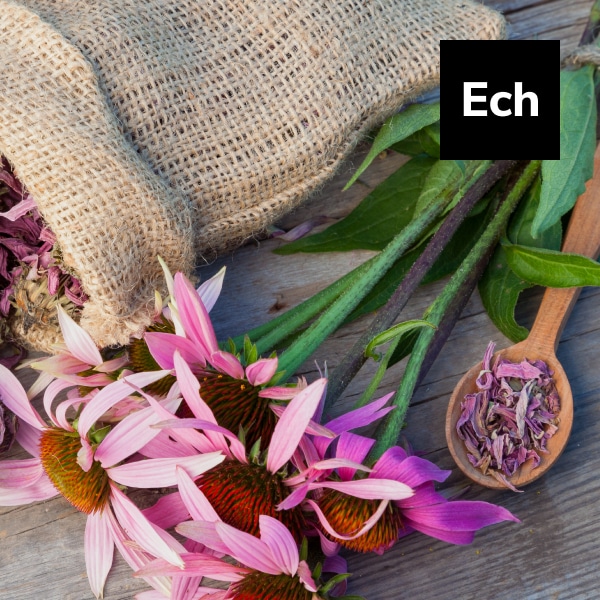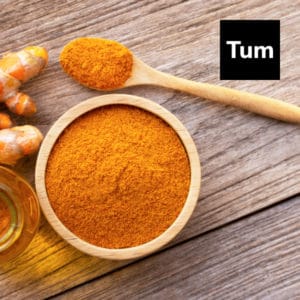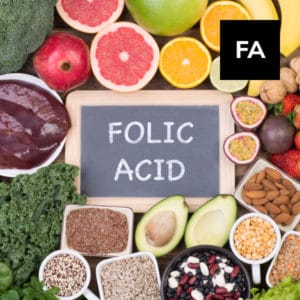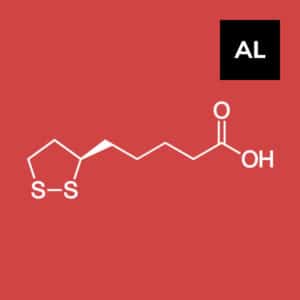Overview
Echinacea is a popular purple coneflower found in many flower gardens. It is a genus of herbaceous flowering plants that has compounds including rosmarinic acid, cichoric acid, and flavonoids that function as antioxidants.
Thousands of studies show that echinacea stimulates the immune system and enhances wound healing. It is a safe and effective herb for reducing the duration of the common cold when taken as soon as symptoms become evident.
Echinacea is widely available in natural health stores, pharmacies, and grocery stores in the form of capsules, tablets, syrups, and tinctures.
Key Benefits
- Enhances immune response
- Supports wound healing and cleansing
- Shortens length of upper respiratory tract infections
- Helps reduce inflammation
History of Usage
Echinacea, a perennial herb native to the Midwestern and Southeastern United States, has been used successfully for hundreds of years. Native Americans utilized it more frequently than any other plant to cure illness and injury, including wounds, snake bites, burns, toothache, and joint discomfort. Although popularity faded with the arrival of antibiotics, Echinacea gained credibility among herbal practitioners in Europe following the publication of the first scientific research in 1932. However, it did not become a popular herb until the early 1980s, when people began looking for natural therapies to aid in the treatment of immunological problems.
The polysaccharide constituents of Echinacea roots have been shown to exhibit anti-inflammatory properties that promote tissue repair, which is why echinacea has a long history of use for the external treatment of wounds, burns, eczema, and other conditions.
Both the plant’s upper and lower sections are now used for oral administration in the form of pills, extracts, fresh-pressed juice, teas, and tinctures. Because of its wide range of healing properties, Echinacea is one of the best-selling herbal extracts in America. It is also one of the top herbal supplements (along with glucosamine and garlic) most frequently used by the elderly.
Biochemistry
Over a thousand scientific investigations have been conducted to ascertain the pharmacology and clinical uses of echinacea. Researchers revealed that the three principal species of Echinacea—Echinacea purpurea, Echinacea pallida, and Echinacea angustifolia—all contain a varied array of active components that alter various elements of immune function. However, Echinacea is predominantly used as an anti-inflammatory, immunostimulant, antibacterial, and vulnerary herb (wound healer)
The plant includes a wide variety of active constituents that influence several elements of immunological function. Echinacea’s polysaccharide and phytosterol ingredients promote white blood cell activation, which benefits the immune system (lymphocytes and macrophages). Additionally, Echinacea stimulates nonspecific T-cell activation, which is necessary for resistance to mold-like bacteria, yeast, fungi, parasites, and viruses (including herpes simplex, Epstein-Barr, and viruses that cause hepatitis). The T cells then produce more interferon, a critical component of the body’s response to viral infections.
Echinacea promotes tissue health by inhibiting hyaluronidase.
Hyaluronidase is an enzyme that degrades hyaluronic acid, a substance that helps maintain tissue integrity. Echinacea has a modest cortisone-like action, enhancing adrenal cortex hormone production. This appears to be the mechanism by which Echinacea exerts its direct anti-inflammatory properties.
Recent Trends
The global Echinacea extract market was worth USD 1.47 billion in 2019 and is expected to reach USD 2.88 billion by 2027, expanding at an 8.25 percent compound annual growth rate between 2020 and 2027.
The usage of Echinacea to aid in the fight against COVID-19 has aided in the herb’s growth, despite the fact that no studies have demonstrated that the plant can prevent the disease. Nonetheless, research indicates that Echinacea may increase overall patient well-being.
Capsules, tablets, extracts, fresh-pressed juice, teas, tinctures, anti-aging lotion, cold treatments, shampoo, face masks, cosmetics, and deodorants are all made from Echinacea’s upper portions and roots.
Precautions
- Pregnant or nursing women should check their health care practitioner before using.
- Echinacea has been known to induce hives, itching, swelling, and anaphylaxis in some people. Can worsen asthma symptoms.
- Before taking Echinacea, those allergic to ragweed, mums, marigolds, or daisies should visit a pharmacist or health care professional.
- Echinacea should not be taken by those with multiple sclerosis, AIDS, TB, leukemia, or autoimmune disorders such as rheumatoid arthritis or lupus, or by those using immunosuppressive medications, due to its immune-boosting effects.
- Not to be used in conjunction with acetaminophen (Tylenol), Singular (montelukast), or Cymbalta (duloxetine)
References
- Shah SA, Sander S, White CM, Rinaldi M, Coleman CI. Evaluation of echinacea for the prevention and treatment of the common cold: a meta-analysis. Lancet Infect Dis. 2007 Jul;7(7):473-80. doi: 10.1016/S1473-3099(07)70160-3. Erratum in: Lancet Infect Dis. 2007 Sep;7(9):580. PMID: 17597571; PMCID: PMC7106401.
- Tubaro A, Tragni E, Del Negro P, Galli CL, et al. Anti-inflammatory activity of a polysaccharide fraction of Echinacea angustifolia J Pharm Pharmacol 1987;39:56-69.
- Vogel VJ: American Indian Medicine. University of Oklahoma Press, Norman, OK, 1970, pp. 356-367.
- Murray, Michael, T. The Healing Power of Herbs. Prima Health, 1995, Rocklin, CA.
- Bruno JJ, Ellis JJ. Herbal use among US elderly: 2002 National Health Interview Survey. Ann Pharmacother. 2005 Apr;39(4):643-8. Epub 2005 Mar 1.
- See DM, Broumand N, Sahl L, Tilles JG. In vitro effects of Echinacea and ginseng on natural killer and antibody-dependent cell cytotoxicity in healthy subjects and chronic fatigue syndrome or acquired immunodeficiency syndrome patients. Immunpharmacol 1997;35:229–35.
- Melchart D, Linde K, Worku F, et al. Immunomodulation with Echinacea—a systematic review of controlled clinical trials. Phytomedicine 1994;1:245–54.
- Block KI, Mead MN. Immune system effects of echinacea, ginseng, and astragalus: a review. Integr Cancer Ther. 2003 Sep;2(3):247-67. doi: 10.1177/1534735403256419. PMID: 15035888.
- Silveira D, Prieto-Garcia JM, Boylan F, Estrada O, Fonseca-Bazzo YM, Jamal CM, Magalhães PO, Pereira EO, Tomczyk M, Heinrich M. COVID-19: Is There Evidence for the Use of Herbal Medicines as Adjuvant Symptomatic Therapy? Front Pharmacol. 2020 Sep 23;11:581840. doi: 10.3389/fphar.2020.581840. PMID: 33071794; PMCID: PMC7542597.




